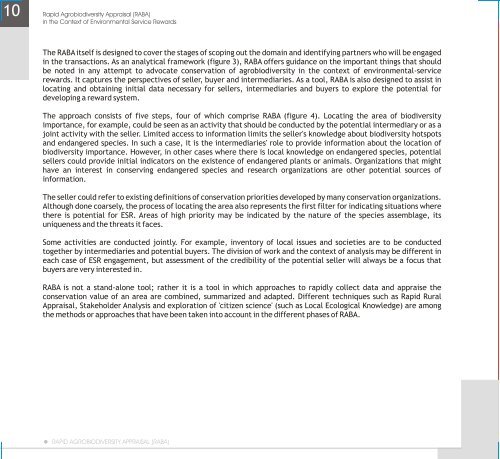Rapid Agrobiodiversity Appraisal (RABA) - Are you looking for one ...
Rapid Agrobiodiversity Appraisal (RABA) - Are you looking for one ...
Rapid Agrobiodiversity Appraisal (RABA) - Are you looking for one ...
Create successful ePaper yourself
Turn your PDF publications into a flip-book with our unique Google optimized e-Paper software.
10<br />
<strong>Rapid</strong> <strong>Agrobiodiversity</strong> <strong>Appraisal</strong> (<strong>RABA</strong>)<br />
in the Context of Environmental Service Rewards<br />
The <strong>RABA</strong> itself is designed to cover the stages of scoping out the domain and identifying partners who will be engaged<br />
in the transactions. As an analytical framework (figure 3), <strong>RABA</strong> offers guidance on the important things that should<br />
be noted in any attempt to advocate conservation of agrobiodiversity in the context of environmental-service<br />
rewards. It captures the perspectives of seller, buyer and intermediaries. As a tool, <strong>RABA</strong> is also designed to assist in<br />
locating and obtaining initial data necessary <strong>for</strong> sellers, intermediaries and buyers to explore the potential <strong>for</strong><br />
developing a reward system.<br />
The approach consists of five steps, four of which comprise <strong>RABA</strong> (figure 4). Locating the area of biodiversity<br />
importance, <strong>for</strong> example, could be seen as an activity that should be conducted by the potential intermediary or as a<br />
joint activity with the seller. Limited access to in<strong>for</strong>mation limits the seller's knowledge about biodiversity hotspots<br />
and endangered species. In such a case, it is the intermediaries' role to provide in<strong>for</strong>mation about the location of<br />
biodiversity importance. However, in other cases where there is local knowledge on endangered species, potential<br />
sellers could provide initial indicators on the existence of endangered plants or animals. Organizations that might<br />
have an interest in conserving endangered species and research organizations are other potential sources of<br />
in<strong>for</strong>mation.<br />
The seller could refer to existing definitions of conservation priorities developed by many conservation organizations.<br />
Although d<strong>one</strong> coarsely, the process of locating the area also represents the first filter <strong>for</strong> indicating situations where<br />
there is potential <strong>for</strong> ESR. <strong>Are</strong>as of high priority may be indicated by the nature of the species assemblage, its<br />
uniqueness and the threats it faces.<br />
Some activities are conducted jointly. For example, inventory of local issues and societies are to be conducted<br />
together by intermediaries and potential buyers. The division of work and the context of analysis may be different in<br />
each case of ESR engagement, but assessment of the credibility of the potential seller will always be a focus that<br />
buyers are very interested in.<br />
<strong>RABA</strong> is not a stand-al<strong>one</strong> tool; rather it is a tool in which approaches to rapidly collect data and appraise the<br />
conservation value of an area are combined, summarized and adapted. Different techniques such as <strong>Rapid</strong> Rural<br />
<strong>Appraisal</strong>, Stakeholder Analysis and exploration of 'citizen science' (such as Local Ecological Knowledge) are among<br />
the methods or approaches that have been taken into account in the different phases of <strong>RABA</strong>.<br />
RAPID AGROBIODIVERSITY APPRAISAL (<strong>RABA</strong>)

















![CynefinFramework final [Read-Only]](https://img.yumpu.com/19017304/1/190x135/cynefinframework-final-read-only.jpg?quality=85)